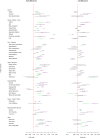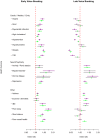Puberty timing associated with diabetes, cardiovascular disease and also diverse health outcomes in men and women: the UK Biobank study
- PMID: 26084728
- PMCID: PMC4471670
- DOI: 10.1038/srep11208
Puberty timing associated with diabetes, cardiovascular disease and also diverse health outcomes in men and women: the UK Biobank study
Abstract
Early puberty timing is associated with higher risks for type 2 diabetes (T2D) and cardiovascular disease in women and therefore represents a potential target for early preventive interventions. We characterised the range of diseases and other adverse health outcomes associated with early or late puberty timing in men and women in the very large UK Biobank study. Recalled puberty timing and past/current diseases were self-reported by questionnaire. We limited analyses to individuals of White ethnicity (250,037 women; 197,714 men) and to disease outcomes with at least 500 cases (~ 0.2% prevalence) and we applied stringent correction for multiple testing (corrected threshold P < 7.48 × 10(-5)). In models adjusted for socioeconomic position and adiposity/body composition variables, both in women and men separately, earlier puberty timing was associated with higher risks for angina, hypertension and T2D. Furthermore, compared to the median/average group, earlier or later puberty timing in women or men was associated with higher risks for 48 adverse outcomes, across a range of cancers, cardio-metabolic, gynaecological/obstetric, gastrointestinal, musculoskeletal, and neuro-cognitive categories. Notably, both early and late menarche were associated with higher risks for early natural menopause in women. Puberty timing in both men and women appears to have a profound impact on later health.
Figures




Comment in
-
Puberty timing has profound effect on later health, study finds.BMJ. 2015 Jun 18;350:h3318. doi: 10.1136/bmj.h3318. BMJ. 2015. PMID: 26092870 No abstract available.
Similar articles
-
Association of puberty timing with type 2 diabetes: A systematic review and meta-analysis.PLoS Med. 2020 Jan 6;17(1):e1003017. doi: 10.1371/journal.pmed.1003017. eCollection 2020 Jan. PLoS Med. 2020. PMID: 31905226 Free PMC article.
-
Age at puberty and risk of asthma: A Mendelian randomisation study.PLoS Med. 2018 Aug 7;15(8):e1002634. doi: 10.1371/journal.pmed.1002634. eCollection 2018 Aug. PLoS Med. 2018. PMID: 30086135 Free PMC article.
-
Pubertal timing and adult obesity and cardiometabolic risk in women and men: a systematic review and meta-analysis.Int J Obes (Lond). 2013 Aug;37(8):1036-43. doi: 10.1038/ijo.2012.177. Epub 2012 Nov 20. Int J Obes (Lond). 2013. PMID: 23164700 Review.
-
Does self-reported pregnancy loss identify women at risk of an adverse cardiovascular phenotype in later life? Insights from UK Biobank.PLoS One. 2019 Oct 23;14(10):e0223125. doi: 10.1371/journal.pone.0223125. eCollection 2019. PLoS One. 2019. PMID: 31644534 Free PMC article.
-
Early puberty: a review on its role as a risk factor for metabolic and mental disorders.Front Pediatr. 2024 Sep 12;12:1326864. doi: 10.3389/fped.2024.1326864. eCollection 2024. Front Pediatr. 2024. PMID: 39328587 Free PMC article. Review.
Cited by
-
Alternate-day fasting delays pubertal development in normal-weight mice but prevents high-fat diet-induced obesity and precocious puberty.Nutr Diabetes. 2024 Oct 4;14(1):82. doi: 10.1038/s41387-024-00335-w. Nutr Diabetes. 2024. PMID: 39366955 Free PMC article.
-
Urinary and salivary endocrine measurements to complement Tanner staging in studies of pubertal development.PLoS One. 2021 May 13;16(5):e0251598. doi: 10.1371/journal.pone.0251598. eCollection 2021. PLoS One. 2021. PMID: 33984062 Free PMC article.
-
Prepubertal Dietary and Plasma Phospholipid Fatty Acids Related to Puberty Timing: Longitudinal Cohort and Mendelian Randomization Analyses.Nutrients. 2021 May 30;13(6):1868. doi: 10.3390/nu13061868. Nutrients. 2021. PMID: 34070864 Free PMC article.
-
Pubertal timing and bone phenotype in early old age: findings from a British birth cohort study.Int J Epidemiol. 2016 Aug;45(4):1113-1124. doi: 10.1093/ije/dyw131. Epub 2016 Jul 10. Int J Epidemiol. 2016. PMID: 27401728 Free PMC article.
-
Pubertal induction and transition to adult sex hormone replacement in patients with congenital pituitary or gonadal reproductive hormone deficiency: an Endo-ERN clinical practice guideline.Eur J Endocrinol. 2022 Apr 21;186(6):G9-G49. doi: 10.1530/EJE-22-0073. Eur J Endocrinol. 2022. PMID: 35353710 Free PMC article.
References
-
- Sorensen K. et al. Recent secular trends in pubertal timing: implications for evaluation and diagnosis of precocious puberty. Hormone research in paediatrics 77, 137–145, doi:10.1159/000336325 (2012). - PubMed
-
- Harrington J. & Palmert M. R. Clinical review: Distinguishing constitutional delay of growth and puberty from isolated hypogonadotropic hypogonadism: critical appraisal of available diagnostic tests. The Journal of clinical endocrinology and metabolism 97, 3056–3067, doi:10.1210/jc.2012-1598 (2012). - PubMed
-
- Parent A. S. et al. The timing of normal puberty and the age limits of sexual precocity: variations around the world, secular trends, and changes after migration. Endocr Rev 24, 668–693 (2003). - PubMed
-
- Prentice P. & Viner R. M. Pubertal timing and adult obesity and cardiometabolic risk in women and men: a systematic review and meta-analysis. International journal of obesity 37, 1036–1043, doi:10.1038/ijo.2012.177 (2013). - PubMed
Publication types
MeSH terms
Grants and funding
LinkOut - more resources
Full Text Sources
Other Literature Sources
Medical
Miscellaneous

